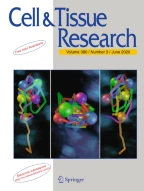- Nadya I. Tarasova1,
- Stephen A. Wank2,
- Eric A. Hudson3,
- Victor I. Romanov4,
- Grzegorz Czerwinski1,
- James H. Resau3 &
- …
- Christopher J. Michejda1
130Accesses
30Citations
9 Altmetric
Abstract.
Endocytosis of gastrin was studied in a number of gastrin-receptor-expressing cell lines by confocal laser scanning microscopy (CLSM) with the aid of a biologically active fluorescent derivative, rhodamine green heptagastrin. Rapid clustering (within 4–7 min) and internalization of fluorescent ligand upon binding at room temperature and 37° C were observed in the rat pancreatic acinar carcinoma cell line AR42J, human gastric carcinomas AGS-P and SIIA, human colon carcinomas HCT116 and HT29, and in NIH/3T3 cells transfected with human and rat gastrin/cholecystokinin-B receptor cDNA. Internalization was inhibited by hypertonic medium. Fluorescent heptagastrin and transferrin colocalized in the same endocytic vesicles at different stages of internalization suggesting that endocytosis occurred predominantly through a clathrin-dependent mechanism. At 37° C partial colocalization with the lysosomal marker neutral red was detected by CLSM, implying that internalized gastrin accumulated in the lysosomes. Immunoelectron microscopy studies with antibodies against gastrin revealed the presence of the internalized hormone in multivesicular vesicles and endosomes. Almost no hormone was detected in lysosomes with the antibodies to gastrin, suggesting that the degradation of the peptide is rapid in those vesicles. Continuous accumulation of fluorescent label was observed by CLSM in the presence of the protein synthesis inhibitor cycloheximide, suggesting that the gastrin receptor is recycled back to the cell membrane after hormone delivery to intracellular compartments. An estimated average recycling time for the receptor molecules was 1 h in NIH/3T3 cells.
This is a preview of subscription content,log in via an institution to check access.
Access this article
Subscribe and save
- Starting from 10 chapters or articles per month
- Access and download chapters and articles from more than 300k books and 2,500 journals
- Cancel anytime
Buy Now
Price includes VAT (Japan)
Instant access to the full article PDF.
Similar content being viewed by others
Explore related subjects
Discover the latest articles, books and news in related subjects, suggested using machine learning.Author information
Authors and Affiliations
Molecular Aspects of Drug Design Section, ABL-Basic Research Program, National Cancer Institute, Frederick Cancer Research and Development Center, P.O. Box B, Frederick, MD 21702, USA, , , , , , US
Nadya I. Tarasova, Grzegorz Czerwinski & Christopher J. Michejda
Digestive Disease Branch, National Institute of Diabetes and Digestive and Kidney Diseases, National Institute of Health, Bethesda, MD, USA, , , , , , US
Stephen A. Wank
Confocal Microscopy, ABL-Basic Research Program, NCI, FCRDC, USA, , , , , , US
Eric A. Hudson & James H. Resau
Membrane Structure Section, Laboratory of Mathematic Biology, National Cancer Institute, USA, , , , , , US
Victor I. Romanov
- Nadya I. Tarasova
Search author on:PubMed Google Scholar
- Stephen A. Wank
Search author on:PubMed Google Scholar
- Eric A. Hudson
Search author on:PubMed Google Scholar
- Victor I. Romanov
Search author on:PubMed Google Scholar
- Grzegorz Czerwinski
Search author on:PubMed Google Scholar
- James H. Resau
Search author on:PubMed Google Scholar
- Christopher J. Michejda
Search author on:PubMed Google Scholar
Additional information
Received: 5 January 1996 / Accepted: 13 June 1996
Rights and permissions
About this article
Cite this article
Tarasova, N., Wank, S., Hudson, E.et al. Endocytosis of gastrin in cancer cells expressing gastrin/CCK-B receptor.Cell Tissue Res287, 325–333 (1997). https://doi.org/10.1007/s004410050757
Issue date:
Share this article
Anyone you share the following link with will be able to read this content:
Sorry, a shareable link is not currently available for this article.
Provided by the Springer Nature SharedIt content-sharing initiative



